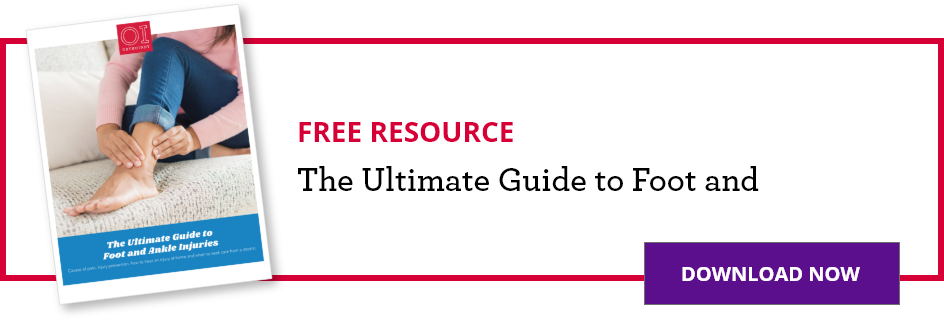THIS POST IS PART OF THE ULTIMATE GUIDE TO SPORTS MEDICINE
Ankle injuries are some of the most common mishaps among sports participants, accounting for nearly half of all athletic injuries. Whether it’s running on uneven surfaces or jumping and not landing quite right on your feet, many of us have seen an ankle injury happen or experienced the pain ourselves.
Ankle sprains
According to Dr. Daniel Lehman, foot and ankle specialist at OrthoIndy, the most common ankle injuries are ankle sprains. There are two types of ankle sprains: an inversion sprain and a high ankle sprain.
“An inversion sprain occurs when the ankle turns inward. Such as stepping into a hole or landing on someone’s foot and rolling your ankle,” said Dr. Lehman. “A high ankle sprain is less common and occurs when the foot is turned outwards.”
Broken ankle
Another type of ankle injury is an ankle fracture. These are more severe injuries and are not as common as ankle sprains.

Symptoms of an ankle injury include
- Swelling
- Bruising
- Pain when walking.
Cause of ankle injuries
“Ankle injuries can occur in any sport. They are most common in basketball, soccer and other jumping sports but can be seen with any sporting activity,” said Dr. Lehman. “Ankle injuries most commonly occur because someone unexpectedly lands on the outside of their foot which causes the ankle to roll in and damages the ligaments on the outside of the ankle.”
Injury prevention
Dr. Lehman also added that the best way to prevent ankle injuries is to make sure that muscle strength is maintained after an injury. Braces or taping can be used to help support the ankle and reduce the risk of injury. Physical therapy can also be helpful in making sure that muscle strength is back and that proper body mechanics are being used.
Ankle pain treatment
To assess an ankle injury a sports medicine specialist will start with a physical examination, which includes an assessment of blood flow, sensation and muscle strength. The exam includes an evaluation of range of motion and ankle stability. The exam also evaluates areas of tenderness, which may lead to X-rays or other diagnostic testing.
“Initial treatment of an ankle injury is dependent on the severity of the injury. For minor sprains, treatment is the RICE regimen which includes rest, ice, compression and elevation,” said Dr. Lehman. “More severe sprains are treated with a period of immobilization in a cast or boot to allow the ligaments to start healing and the initial swelling and pain to subside before starting a rehab program. Ankle fractures are usually treated either with a cast/boot or surgery depending on the severity of the injury.”
An athlete is usually able to return to his or her sport in one to two weeks after an ankle sprain. For more severe ankle injuries an athlete may be out for up to 12 weeks. This is because ankle sprains typically take a minimum of 6 weeks to heal and are then followed by rehab to recover muscle strength and motion.
To schedule an appointment with Dr. Lehman please call 317.802.2818 or learn more about foot and ankle treatment at OrthoIndy.
Schedule an appointment
Your well-being is important to us. Click the button below or call us to schedule an appointment with one of our orthopedic specialists. If your injury or condition is recent, you can walk right into one of our OrthoIndy Urgent Care locations for immediate care. For rehabilitation and physical therapy, no referral is needed to see one of our physical therapists.





